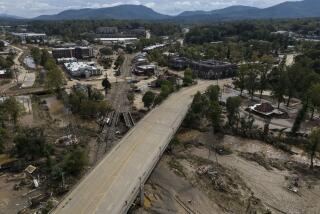Homes for Refugees Top World Bank’s ’97 Bosnia Plan
The World Bank hopes to commit $1.4 billion to rebuild war-torn Bosnia-Herzegovina this year with a special emphasis on providing homes for returning refugees, bank officials said Friday.
Christine Wallich, director of the World Bank’s Bosnia program, said that in 1997, housing construction and other measures needed to ease the return of refugees “will take a much more important direction” than they did last year.
At the same time, she acknowledged that refugees are unlikely to return to their prewar homes in significant numbers as long as they face armed men determined to keep them out.
Last year, she said, most refugee resettlement was concentrated on assisting people to return to cities and villages where their ethnic group is still in the majority.
She acknowledged that it will be much more difficult to resettle the far greater share of refugees who were driven from their homes by “ethnic cleansing” that left their communities in the hands of their enemies.
In a report marking the end of the first year of the reconstruction program established by the peace accords brokered in Dayton, Ohio, the bank said international aid “has jump-started the economy” in the Muslim-Croat Federation, which received most of the $1.8 billion budgeted for Bosnia assistance in 1996.
The bank is coordinating the program, although the money comes from almost 60 countries and organizations.
Wallich said the organization wants to increase its assistance to the Bosnian Serb entity, the Republika Srpska, this year, possibly equaling the amount given to the federation.
But she said that will not happen unless the Serbs begin to comply with their obligations under the Dayton accords, such as allowing the free return of refugees and turning over indicted war criminals to an international tribunal for trial.
She said the bank hopes to give Bosnians on each side of the ethnic divide a taste of the benefits of peace and “a stake in a prosperous future.”
She said the bank also plans to stress private-sector development in the coming year, especially reform of the private banking system, which is so little trusted by Bosnians that it is almost useless as a mechanism for economic development.
Other items on the 1997 priority list are continuation of existing programs to improve utilities and transportation and creation of government institutions, such as a central bank and a budget authority.
Despite continuing ethnic hostility in Bosnia, which has dampened much of the optimism that followed the Dayton peace conference, Wallich said the bank is satisfied with the first year of international aid programs.
Like the North Atlantic Treaty Organization-led international peacekeeping force, the World Bank declared success in meeting the objectives it set for itself.
In the Muslim-Croat Federation, which received 84% of the assistance, Wallich said, the economic growth rate shot up to between 35% and 40% last year from a dead stop the year before. Unemployment, which had topped 90%, dropped to between 50% and 60%.
In the Serbian entity, which received only 2% of the aid, the economy stagnated. The other 14% of the assistance went to the weak federal government covering both halves of the divided country.
Wallich said the clear economic advantage of the federation over the Serbian entity demonstrated the impact of international aid.
The United States, European Union, Japan and other donors promised $5.1 billion for Bosnia reconstruction over three or four years.
Last year the budget was $1.8 billion, of which $1.2 billion had been committed by the end of October. The target drops to $1.4 billion this year and will decline further in the next two years.
Wallich said international aid will cover only about 25% of the amount Bosnia needs to rebuild by the end of the century. The rest will have to come from private investment, which is lagging.
Still, the $5.1-billion figure, if it is all raised and spent, would amount to $1,275 for each of Bosnia’s 4 million people. On a per-capita basis and adjusted for inflation, that makes the Bosnia program more than four times the size of the Marshall Plan that rebuilt Europe after World War II.
More to Read
Sign up for Essential California
The most important California stories and recommendations in your inbox every morning.
You may occasionally receive promotional content from the Los Angeles Times.










